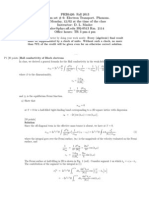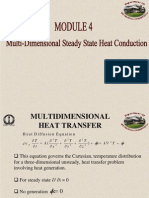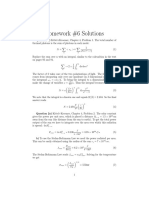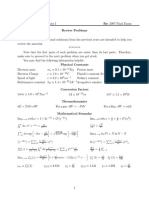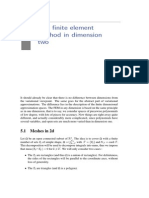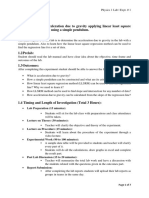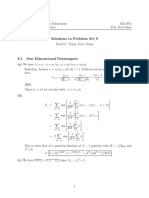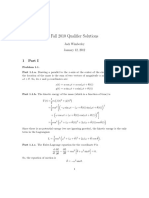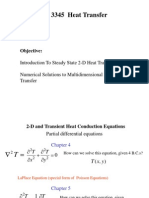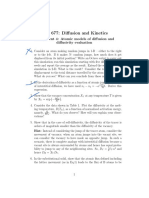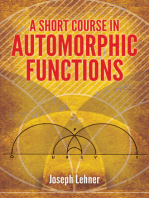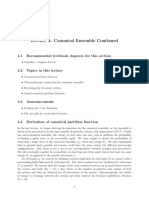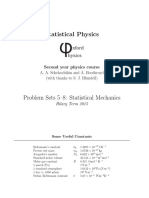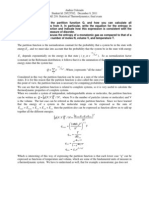2007fall PDF
2007fall PDF
Uploaded by
Shweta SridharCopyright:
Available Formats
2007fall PDF
2007fall PDF
Uploaded by
Shweta SridharOriginal Description:
Original Title
Copyright
Available Formats
Share this document
Did you find this document useful?
Is this content inappropriate?
Copyright:
Available Formats
2007fall PDF
2007fall PDF
Uploaded by
Shweta SridharCopyright:
Available Formats
PHYSICS DEPARTMENT EXAM
FALL 2007. PART I
INSTRUCTIONS
Please take a few minutes to read through all problems before starting the
exam. Ask the proctor if you are uncertain about the meaning of any part of
any problem. The questions are grouped in ve Sections: Mechanics, E&M,
Quantum, StatMech, and General. You must attempt at least one problem
from each Section. Credit will be assigned for seven (7) questions only.
You should not have anything close to you other than your pens, pencils,
calculator, and food items. Please deposit your belongings (books, notes,
backpacks, etc.) in a corner of the exam room.
Departmental examination paper is provided. Colored scratch paper is
also provided. Please make sure you:
a. Write the problem number and your ID number on each sheet;
b. Write only on one side of the paper;
c. Start each problem on the attached examination sheets;
d. If multiple sheets are used for a problem, please make sure you staple
the sheets together and make sure your ID number is written on each
of your exam sheets.
At the conclusion of the examination period, please staple sheets from each
problem together. Circle the seven problems you wish to be graded:
Mechanics E & M Quantum Stat Mech General
1 2 3 4 5 6 7 8 9 10
Submit this top sheet to one of the proctors, who will check that you have
circled the correct problem numbers above. Then submit your completed
exam, separated into stacks according to problem number.
CODE NUMBER: SCORE: 1
#1 : UNDERGRADUATE CLASSICAL MECHANICS
PROBLEM: A rope of mass M and length L is suspended in the earths grav-
itational eld, g, with the bottom end of the rope touching a surface. The
rope is then released from rest and falls limply on the surface (i.e., without
the elements bouncing upwards). Find the force F(t) on the surface as a
function of time, 0 < t < , and make a sketch of it. At what time does
F(t) reach its maximum? What is the value of this maximum force?
SOLUTION: All the elements of the rope are in free fall. It takes time T =
_
2L/g for the last element to reach the surface. Hence, at t > T we have
F(t) = Mg , t > T .
Consider now 0 < t < T. Here F is a sum of two terms, F = F
1
+F
2
. The
rst one is the the weight F
1
= lg of the part that has already fallen. Here
l(t) = gt
2
/2 is the length of the fallen piece and = M/L is the mass per
unit length. The second term is the transfer of momentum F
2
= dP/dt from
the element of length dl = vdt that comes to rest during the time (t, t +dt).
The velocity of this segment is v = gt, and so F
2
= v(vdt)/dt = g
2
t
2
.
Accordingly,
F(t) =
1
2
g
2
t
2
+g
2
t
2
=
3
2
M
L
g
2
t
2
= 3Mg
t
2
T
2
, 0 < t < T .
We see that F reaches a maximum F = 3Mg at t = T, then experiences a
sudden drop to the three times smaller value, after which it remains constant.
CODE NUMBER: SCORE: 2
#2 : UNDERGRADUATE CLASSICAL MECHANICS
PROBLEM: A wedge of mass M rests on a horizontal frictionless surface. A
point mass m is placed on the wedge, whose surface is also frictionless. Find
the horizontal acceleration a of the wedge.
SOLUTION: Let N be the normal reaction force, then the Newton equation
for the wedge projected on the horizontal axis gives
Ma = N sin N = Ma/ sin.
Consider now the motion of the small mass. Its acceleration is a +a
. The
second term a
is along the incline, and so it vanishes if projected on the
direction normal to the incline. The corresponding Newton law reads
ma sin = N mg cos .
Substituting N from the rst equation and solving for a, we get
a = g
sincos
(M/m) + sin
2
.
CODE NUMBER: SCORE: 3
#3 : UNDERGRADUATE ELECTROMAGNETISM
PROBLEM: A circular loop of wire is of radius R and carries current I. The
wire lies in the plane z = 0 with its center at the origin of coordinates. Let
(, , z) be the cylindrical coordinates. Determine:
(a) Magnetic eld B at a given point (0, 0, z) on the z-axis.
(b) The radial component B
(, , z) of B at a distance R o the z-axis.
Hint: For an arbitrary vector X
div X =
1
(X
) +
1
+
z
X
z
.
SOLUTION: (a) By symmetry, B = B
z
z at = 0. Let Idl be the dierential
current element along the ring, then the Biot-Savart law yields
dB
z
=
Idl
c
sin
R
2
+z
2
, sin =
R
R
2
+r
2
,
where is the angle between the vector connecting this element to the
observation point and the vertical. Integration over the ring leads to dl
2R, and so
B
z
=
2I
c
R
2
(R
2
+z
2
)
3/2
.
(b) By Taylor expansion
B
(0, 0, z) C , R.
Next,
0 = div B|
=0
= 2C +
z
B
z
C =
z
B
z
/2 .
Computing the last derivative, we nally get
B
3I
c
R
2
z
(R
2
+z
2
)
5/2
.
CODE NUMBER: SCORE: 4
#4 : UNDERGRADUATE ELECTROMAGNETISM
PROBLEM: A spiral spring has N turns and initial length x
0
. How does its
length changes if a small current I is made to ow through it? The spring
has an elastic constant k for longitudinal deformations. Assume that the
spring can be treated as a perfect solenoid and that its radius R remains
xed.
SOLUTION: It is convenient to think that the current I was created by some
external source while the spring was kept at the original length x
0
. The
coil was then short-circuited leaving the current owing. Finally, the spring
was allowed to expand or contract freely. In this formulation, the magnetic
ux = LI remains constant since the circuit has zero resistance, which
simplies the derivation.
Since the current ows in the same direction in the adjacent coils of the
spring, these coils attract. Hence, the spring would shorten. Let x be the
new length. To nd the contraction x = x x
0
we can minimize the sum
of the magnetic and the elastic energy,
E =
2
2c
2
L
+
k
2
(x)
2
.
where
L = 4
2
N
2
R
2
/c
2
x
is the inductace of the spring (the derivation of this known formula is ele-
mentary). Since = const, it is easy to take the derivative of E with respect
CODE NUMBER: SCORE: 5
to x. Equating it to zero, one nds that the mimimum energy is reached at
x
2
2
c
2
N
2
R
2
I
2
kx
2
0
.
CODE NUMBER: SCORE: 6
#5 : UNDERGRADUATE QUANTUM MECHANICS
PROBLEM: Consider a one-dimensional quantum particle with the Hamil-
tonian
H = T +V (x) , T =
2
2m
d
2
dx
2
.
Suppose that m suddenly changes from m
0
to m
1
= m
0
/ at t = 0. As-
suming the particle was in the ground state at t < 0, nd: (i) probability to
remain in the ground state at t > 0 and (ii) change in the energy expectation
value H. Consider two cases:
(a) Innite square well, i.e., V (x) = 0 for 0 < x < L and innite otherwise.
(b) Parabolic well, V (x) = Cx
2
/ 2. Hint: For any a > 0,
dxexp(ax
2
) =
_
a
.
SOLUTION: In a sudden perturbation the wavefunction does not change;
hence, the probability in question is the squared overlap of the two ground-
state wavefunctions,
1
|
0
2
. The potential energy V also does not
change. Therefore,
H|
t=+0
t=0
= T|
t=+0
t=0
= ( 1)T|
t=0
.
(a) In this case the ground-state wavefunction
0
= sin(x/L) at t < 0 is
also the ground state
1
at t > 0; hence the probability to remain in the
ground state is 1. The change in energy is
H|
t=+0
t=0
=
1
2
2
m
0
L
2
.
(b) The normalized ground-state wavefunction is =
1/4
l
1/2
exp(x
2
/2l
2
),
where l = (
2
/mC)
1/4
. The overlap is
1
|
0
=
1
1
(l
0
l
1
)
1/2
dxexp
_
x
2
2
_
1
l
2
0
+
1
l
2
1
__
=
2l
0
l
1
l
2
0
+l
2
1
.
CODE NUMBER: SCORE: 7
The probability in question is
1
|
0
2
=
2l
0
l
1
l
2
0
+l
2
1
=
2(l
1
/l
0
)
1 + (l
2
1
/l
2
0
)
=
2
1/4
1 +
1/2
< 1 .
The change in energy is
H|
t=+0
t=0
=
1
4
0
( 1) =
1
4
_
C
m
0
.
CODE NUMBER: SCORE: 8
#6 : UNDERGRADUATE QUANTUM MECHANICS
PROBLEM: A particle of mass m is placed above a rigid horizontal surface. In
the presence of a gravitational eld g its vertical motion is quantized. Find
the asymptotic expression for the nth energy level for n 1, with n = 0
being the ground state.
SOLUTION: To get the requested accuracy, it is sucient to use the standard
WKB approximation,
n
(z) =
cos[(z) /4]
_
k(z)
, (z) =
H
_
z
k()d , k(z) =
_
2m
2
(E
n
mgz) ,
where E
n
is the WKB value of the energy and H = E
n
/mg is the classical
turning point. The phase shift /4 in the argument of the cosine is impor-
tant: it ensures that
n
matches onto an exponentially decaying solution at
z > H. The boundary condition
n
(0) = 0 is met if (0) = (n +3/4), i.e.,
H
_
0
d
_
2m
2
(E
n
mg) =
2
3
2m
mg
E
3/2
n
= (n + 3/4) , n = 0, 1, . . . ,
so that
E
n
_
9
8
_
n +
3
4
_
2
2
g
2
m
_
1/3
, n 1 .
This expression is accurate to o(1/n), and so keeping the term 3/4 on the
background of n is still legitimate.
CODE NUMBER: SCORE: 9
#7 : UNDERGRADUATE STATISTICAL MECHANICS
PROBLEM: Molecules of an ideal gas have internal energy levels that are
equidistant, E
n
= n, where n = 0, 1, . . . and is the level spacing. The
degeneracy of nth level is n + 1. Find the contribution of these internal
states to the energy of the gas of N molecules at temperature T.
SOLUTION: For a non-interacting ideal gas,
E =
N ln ,
where is the single-molecule partition function
=
n=0
(n + 1) exp(n) .
This partition function can be evaluated as follows (x ):
= e
x
d
dx
n=0
exp
_
(n + 1)x
_
= e
x
d
dx
e
x
1 e
x
= [1 exp()]
2
.
Hence, the sought contribution to the energy is
E =
2N
exp(/kT) 1
.
Alternatively, one can reproduce this result as follows. One can imagine that
every molecule has two independent internal degrees of freedom of harmonic
oscilator type, with energy spacing each. It is easy to see that this model
gives the same spectrum and degeneracies if the energy is counted from the
ground state. With this convention, the average energy of a single harmonic
oscillator is n
B
(), where n
B
() is the Bose-Einstein occupation number.
Therefore, for the entire gas we get E = 2Nn
B
(), in agreement with the
rst derivation.
CODE NUMBER: SCORE: 10
#8 : UNDERGRADUATE STATISTICAL MECHANICS
PROBLEM: What is the change of entropy that occurs when two moles of an
ideal gas A and three moles of an ideal gas B, both at standard temperature
and pressure are allowed to mix? What if the gases are the same, e.g., A
and A?
SOLUTION: As we will show, the entropy increases if the gases being mixed
are not identical. According to the general principles of statistical mechan-
ics, the entropy is S = k lnW, where W is the number of microstates that
correspond to a given macrostate. For an ideal gas, we have W = W
tr
W
int
where W
tr
and W
int
are number of microstates due to translational and
internal degrees of freedom, respectively. If this gas is non-degenerate, then
W
tr
=
1
N!
_
V
3
T
_
N
_
e
3
T
V
N
_
N
, N 1 ,
where N is the number of molecules, V is the volume, and
3
T
is the cube
of the thermal wavelength (eectively, the volume occupied by a mole-
cule at temperature T). The important factorial term N! eliminates the
overcounting of states for indistinguishable particles.
The only parameters that change as a result of the mixing are V and the
number of moles n. Therefore, we can write
S(n) = nRln(V/n) + const ,
where R is the universal gas constant. Note that at standard temperature
and pressure V and n are directly proportional, V = (22.4 l) n. Using this
fact, the increase in entropy due to the mixing can be written as
S = S
A
+S
B
= n
1
Rln
_
V
1
+V
2
V
1
_
+n
2
Rln
_
V
1
+V
2
V
2
_
= n
1
Rln
_
n
1
+n
2
n
1
_
+n
2
Rln
_
n
1
+n
2
n
2
_
= Rln
_
3125
108
_
3.4R.
On the other hand, if the gases were identical, e.g., A and A, then
S = (n
1
+n
2
)Rln
_
V
1
+V
2
n
1
+n
2
_
n
1
Rln
_
V
1
n
1
_
n
2
Rln
_
V
2
n
2
_
= 0 ,
as expected.
CODE NUMBER: SCORE: 11
#9 : UNDERGRADUATE GENERAL
PROBLEM: Lightning is known to release a large amount of energy in a form
of a short burst. Let W be the energy output per unit length of the lightning
and f be the dominant acoustic frequency of the thunder it emits.
(a) Use dimensional analysis to express W in terms of f and physical para-
meters of the surrounding air, e.g., the speed of sound, density, etc.
(b) Under typical conditions, the thunder is heard at f = 100 Hz, the speed
of sound in air is v = 343 m/s, and the length of the lightning is 1 km.
Estimate the total energy produced by such a lightning and compare it with
the energy release of one ton of TNT explosive, 4.6 10
9
J.
SOLUTION: (a) A sudden release of a large energy along the track of the
lightning creates an initially rapidly expanding cylinder of a superhot gas.
Remembering that the thermal velocity of molecules coincides with the speed
of sound v up to a coecient, we conclude that the expansion of a very hot
gas is necessarily supersonic. Hence, it creates a shock wave. Since the
energy is delivered as a short burst rather than continuously, the expanding
gas cools down, slows down, and the shock eventually becomes subsonic. At
that moment the sound waves can run ahead of it and be heard as thunder.
This description suggests that the most important here are the inertial and
sound propagation characteristics of air, i.e., mass density and the speed
of sound v. Temperature, diusion coecient, viscosity, etc, are irrelevant
because the process is far from equilibrium. Ambient air pressure P does not
add anything either because P v
2
. Hence, we expect W = W(f, , v).
We try the scaling form
W = cf
,
where c, , , and are some dimensionless numbers. The requirement of
W to have correct units xes the last three as follows:
W = cv
4
/f
2
W [J/m] = c
[kg/m
3
] (v [m/s])
4
(f [Hz])
2
.
Hence, the lower the frequency of the thunder, the higher must be the en-
ergy of the lightning. Although it may seem counterintuitive, it can be
understood based on the argument that the wavelength of the thunder is set
by the radius of the supersonic core around the lightning. Obviously, this
radius increases with W.
CODE NUMBER: SCORE: 12
(b) For a crude estimate, we can drop the unknown numerical coecient
c. Using the suggested numbers of f = 100 Hz, v = 343 m/s, and also
= 1.2 kg/m
3
, we get W = 1.7 10
6
J/m. Hence, the total energy released
by the lightning is 1.7 10
9
J or 0.4 ton of TNT.
CODE NUMBER: SCORE: 13
#10 : UNDERGRADUATE GENERAL
PROBLEM: Ideal gas has density n, molecular mass m, initial temperature
T
0
, and collisional cross-section . At time t = 0 a small amount of heat
Q is released in a neighbourhood of a point inside the gas. Determine how
the temperature dierence T T
0
at that point decays at large time t. No
detailed calculations are necessary; rather, use estimates and dimensional
analysis to derive the scaling trend.
SOLUTION: Small heat disturbances spread by thermal conductivity. At
large time the size of the heated region is R(t)
D
T
t, where D is the
thermal diusion coecient. In an ideal gas D
T
is of the same order as
the regular diusion coecient D = v
T
l/3, where v
T
=
_
3kT
0
/m is the
thermal velocity and l = 1/n is the mean-free path. The conservation of
energy requires
cnR
3
(t)[T(t) T
0
] Q,
where c k is the specic heat per molecule. Therefore,
T(t) T
0
Q
kn
_
2
n
2
m
kT
0
_
3/4
1
t
3/2
.
CODE NUMBER: SCORE: 1
#11 : GRADUATE CLASSICAL MECHANICS
PROBLEM: Three identical strings are connected to a ring of mass m that can
slide frictionlessly along a vertical pole. Each string has tension and the
linear mass density . In equilibrium, all strings are in the same horizontal
plane. The motion of the strings is in the vertical z-direction.
We can choose coordinates x
1
, x
2
, and x
3
for the three strings, with <
x
i
0 and the ring position being x
i
= 0. When a plane wave of a given
momentum k is incident on the ring from the rst string, it creates trans-
mitted waves down the other two strings and a reected wave on the rst
string:
z
1
=
f(k) exp(ikx
1
it) + g(k) exp(ikx
1
it) ,
z
2
=
h
A
(k) exp(ikx
2
it) , z
3
=
h
B
(k) exp(ikx
3
it) .
(a) Write the set of equations of motion for the problem. Dene all coe-
cients, e.g., c /k.
(b) Find the reection coecient g(k)/
f(k).
(c) Test the correctness of your formula by considering two limits, k 0 (a
very long and slow pulse) and k (a very short and fast one).
CODE NUMBER: SCORE: 2
SOLUTION: (a) The wave equations read
2
z
i
x
2
i
=
1
c
2
2
z
i
t
2
, c =
_
.
Next, if Z exp(it) is the vertical coordinate of the ring, then Newtons
second law implies F = m
2
Z exp(it). Here the force F on the ring
is the sum of the vertical components of the tension in the three strings at
x
i
= 0:
F =
3
i=1
z
i
x
i
x
i
=0
= ike
it
(
f g
h
A
h
B
) .
(b) The continuity at the ring demands
Z =
f + g =
h
A
=
h
B
.
Eliminating
h
A
and
h
B
from the Newtons law for the ring, we readily obtain
g(k) =
_
k +iQ
k + 3iQ
_
f(k) ,
where Q /mc
2
has dimensions of inverse length. Substituting this into
formulas for
h
A
and
h
B
, we have
h
A
(k) =
h
B
(k) =
_
2iQ
k + 3iQ
_
f(k) .
(c) For a very long wavelength pulse, composed of plane waves for which
|k| Q, we have g(k)
1
3
f(k). Thus, the reected pulse is inverted,
and is reduced by a factor of 3 in amplitude. The other outgoing pulses
have amplitudes (2/3)
f. This is consistent with the energy conservation:
1
2
= (1/3)
2
+ (2/3)
2
+ (2/3)
2
(for 0, the ring oscillates very slowly,
and so it has no appreciable kinetic energy). Conversely, for a very short
wavelength pulse, k Q, we have perfect reection with inversion, and no
transmission. This is due to the inertia of the ring.
CODE NUMBER: SCORE: 3
#12 : GRADUATE CLASSICAL MECHANICS
PROBLEM: The pivot of an inverted simple pendulum is rapidly oscillated
vertically with amplitude a and frequency (see diagram).
Find a condition on such that = 0 is a point of stable equilibrium.
Hint: Separate the equation of motion into fast and slow parts. Elim-
inate the former. The remaining equation for the slow part determines
whether the system is stable.
SOLUTION: In the oscillating frame of the pivot,
g
e
= g +
d
2
y
dt
2
= g
2
a cos t .
Therefore,
=
g
(1
2
a
g
cos t) .
Let us decompose into a slow and a fast
1
parts:
= (t) +
1
(t) ,
then
d
2
1
dt
2
+
d
2
dt
2
=
g
(1
2
a
g
cos t)( +
1
) .
The fast equation is
d
2
1
dt
2
=
g
2
a
g
cos t
1
=
a
cos t .
CODE NUMBER: SCORE: 4
The slow equation is
d
2
dt
2
=
g
1
cos t
2
a
g
=
g
(1
2
a
g
a
2
)
The stability is achieved if
2
a
2
2g
> 1 .
CODE NUMBER: SCORE: 5
#13 : GRADUATE ELECTROMAGNETISM
PROBLEM: A relativistic electron radiates while executing a nearly circular
cyclotron motion in a uniform magnetic eld B. Find how the function
(t) E(t)/ mc
2
decreases with time t starting from some initial value
(0). Assume that (t) 1 and that the energy radiated during one period
of cyclotron motion is small compared to the electron energy E(t).
Hint: the power W radiated by a relativistic electron can be written as
W =
2
3
e
2
m
2
c
3
dp
d
dp
d
,
where p
= (E/c , P) and p
= (E/c , P) are contravariant and covariant
4-momenta, respectively, and is the proper time.
SOLUTION: The relation between the proper and lab time is
d = dt
_
1
v
2
c
2
=
dt
(t)
.
Therefore,
dp
d
= (t)
_
1
c
dE
dt
,
dP
dt
_
,
dp
d
= (t)
_
1
c
dE
dt
,
dP
dt
_
.
For motion in magnetic eld
dE
dt
= 0 ,
dP
dt
=
e
c
[v B] .
Hence,
W =
2
3
e
2
m
2
c
3
2
(t)
v
2
c
2
e
2
B
2
2
3
e
4
m
2
c
3
2
(t)B
2
.
The energy balance equation becomes
d
dt
(mc
2
) = W =
e
4
m
2
c
3
2
(t)B
2
,
which has the solution
1
(t)
=
1
(0)
+
2
3
e
4
B
2
m
3
c
5
t .
CODE NUMBER: SCORE: 6
#14 : GRADUATE ELECTROMAGNETISM
PROBLEM: A small amount of water is being warmed in a microwave oven.
(a) Derive the formula for the amplitude E of the electric eld in terms of
the power P dissipated in a unit volume of water, microwave frequency f
(in Hz), and the complex dielectric function of water =
1
+ i
2
. Assume
that the eld penetrates the water uniformly.
(b) Compute the voltage drop V (assuming uniform eld) across the longest
dimension of the oven, L = 0.3 m. Use the following information. Typically,
it takes about a minute to heat a cup of water by 10
C, so that P
10
6
W/m
3
. The microwave frequency is = 2f, where f = 2.45 GHz. At
such frequency the dielectric function of water is 80 + 10i.
SOLUTION: (a) Let be the real part of the conductivity. In the Gaussian
units =
2
/4 = f
2
/2. The ac Joule heating is
P =
1
2
E
2
=
1
4
f
2
E
2
.
Therefore,
E = 2
_
P/f
2
.
(b) Substituting the numbers, we get
E [statV/cm] 2
_
10
7
[erg/cm
3
]/ 2.45 10
9
[Hz]/ 10
= 0.04 [statV/cm] = 1.2 kV/m.
Accordingly, the voltage drop across the oven is V = EL 360 V.
One more consideration is in order to get the correct estimate for V . (How-
ever, failure to acknowledge it was not penalized by taking o points in
grading the exam).
Strictly speaking, the eld E we computed is actually the eld inside the
water. The magnitude of the eld E
out
in the rest of the oven is larger:
E
out
= E[1 + ( 1)N]
where N is referred to as the depolarization factor. If water forms a very
shallow puddle and the microwave eld is parallel to its surface, i.e., hori-
zontal, N is very small and E
out
E, so the above estimate of V stands.
CODE NUMBER: SCORE: 7
However, if the dimensions of the volume occupied by the water are compa-
rable (e.g, water lling a common mug), then f 1/3, so that
|E
out
| |E|/3 30|E| .
Therefore, the actual total voltage across the microwave oven is 360 V
30 10 kV. This explains why safety features are necessary.
CODE NUMBER: SCORE: 8
#15 : GRADUATE QUANTUM MECHANICS
PROBLEM: A particle of mass m moves in a spherically symmetric potential
well V (r) = V
0
< 0 at r < a and V (r) = 0 at r > a. Find the smallest V
0
at which a bound state exists at zero angular momentum.
SOLUTION: The Schr odinger equation for zero angular momentum reads
2
2m
_
(r) +
2
r
(r)
_
= E , r > a ,
2
2m
_
(r) +
2
r
(r)
_
= (V
0
+E) , r < a ,
The sought solution for E < 0 is
(r) = Aexp(r)/r , =
2mE/ , r > a ,
(r) = Bsin(r)/r , =
_
2m(V
0
+E)/ , r < a ,
The continuity of
(r)/(r) at r = a demands
cot a = ,
As E 0
, 0
+
, and so a /2. Thus,
minV
0
=
2
2
8ma
2
.
CODE NUMBER: SCORE: 9
#16 : GRADUATE QUANTUM MECHANICS
PROBLEM: A system is described by the Hamiltonian H = H
0
+ H
1
. H
0
has a doubly-degenerate ground state of zero energy. The corresponding
eigenkets are |1 and |2. H
1
has the property that 1|H
1
|1 = 2|H
1
|2 = 0
and 1|H
1
|2 = a. Finally, is a small parameter.
(a) Find the two lowest energy states and the corresponding eigenkets of the
Hamiltonian H accurate to the lowest non-vanishing order in .
(b) Write down a general expression for the ket |(t) in terms of the eigen-
kets found above.
(c) Calculate the probability of nding the system in the state |1 at time t
if it was in the state |2 at t = 0.
SOLUTION: (a) The Hamiltonian H projected on the Hilbert space spanned
by |1 and |2 can be written in the form of the 2 2 matrix
H =
_
0 a
a
0
_
.
Let a = |a|e
i
. Diagonalizing the above matrix, we nd that the two lowest-
energies are E
s
= |a| and E
a
= |a|. The corresponding eigenstates are
|s =
e
i/2
2
|1 +
e
i/2
2
|2 , |a =
e
i/2
2
|1
e
i/2
2
|2 .
(b) The answer is ( = 1):
|(t) = c
s
e
i|a|t
|s +c
a
e
i|a|t
|a , c
s
= s|(0) , c
a
= a|(0) .
(c) It is easy to see that
c
s
= s|2 =
e
i/2
2
, c
a
= a|2 =
e
i/2
2
.
In addition,
d
s
1|s =
e
i/2
2
, d
a
1|a =
e
i/2
2
,
CODE NUMBER: SCORE: 10
whence
1|(t) = d
s
e
i|a|t
c
s
+d
a
e
i|a|t
c
a
=
1
2
_
e
i|a|t
e
i|a|t
_
= i sin|a|t ,
and so the probability in question is
|1|(t)|
2
= sin
2
|a|t .
CODE NUMBER: SCORE: 11
#17 : GRADUATE STATISTICAL MECHANICS
PROBLEM: A system is composed of N identical classical oscillators, each
of mass m, dened on a one-dimensional lattice. The potential for the
oscillators has the form
U(x) = |x/a|
n
, > 0, n > 0 .
(Thus, the oscillators are harmonic for n = 2 and anharmonic otherwise).
Find the average thermal energy at temperature T.
Hint: An integral that appears in the course of evaluating the partition
function cannot be computed in terms of elementary functions. Fortunately,
it amounts only to an unimportant overall coecient.
SOLUTION: Classical partition function for a single oscillator is
=
dp exp
_
p
2
/2m
_
_
dxexp(|x/a|
n
) .
By change of variables, we bring this to the form
= (1/2)(1/n)
2a
n
_
2m
_
1/2
_
1
_
1/n
,
where
(z)
_
0
dt t
z1
exp(t) .
A learned reader would recognize this as the Euler Gamma-function. How-
ever, knowing this is not necessary. The product (1/2)(1/n) is just a
numerical coecient, which will disappear from the nal result.
The average energy is given by
E = N
ln =
_
n + 2
2n
_
NkT .
This result resembles the equipartition theorem in the sense that material
constants do not enter.
CODE NUMBER: SCORE: 12
#18 : GRADUATE STATISTICAL MECHANICS
PROBLEM: The Hamiltonian of N noninteracting spin-1/2 particles in mag-
netic eld H is given by
H
0
= HM , M =
N
i=1
i
,
i
= 1 .
(a) Calculate the average magnetization M, the averare square of the
magnetization M
2
, and the magnetic susceptibility = (d/dH)M at
temperature T.
(b) Verify that your results obey the thermodynamic identity
M
2
M
2
= kT.
(c) Prove that the above identity holds even in the presence of interactions,
H
0
H
0
+ H
int
, for arbitrary H
int
({
i
}).
SOLUTION: A shorter derivation can be given if we start with part (c).
(c) The partition function is
Q =
{
i
}
exp
_
HM({
i
}) E
int
({
i
})
_
,
whence
M =
1
Q
Q
H
, M
2
=
1
2
Q
2
Q
H
2
.
Now
=
H
M =
1
Q
2
Q
H
2
1
Q
2
_
Q
H
_
2
= (M
2
M
2
) ,
which proves the identity.
(a) We can now apply the above formulas to the problem in hand. We have
Q =
i
exp(H
i
) = [2 cosh(H)]
N
.
CODE NUMBER: SCORE: 13
Taking the requisite derivatives, we nd
M = Ntanh(H) ,
M
2
=
2
[N(N 1) tanh
2
(H) +N] ,
=
2
Nsech
2
(H) .
(b) We have
2
[N(N 1) tanh
2
(H) +N] [Ntanh(H)]
2
=
2
N[1 tanh
2
(H)]
=
2
Nsech
2
(H) = kT.
CODE NUMBER: SCORE: 14
#19 : GRADUATE GENERAL
PROBLEM: Small transverse oscillations u(z, t) of an inextensible but other-
wise perfectly exible cable suspended at one end and hanging under gravity
are described by the equation
2
u
t
2
=
z
_
gz
z
u
_
, u(L, t) = 0 ,
where L = const is the length of the cable and 0 < z < L is the vertical
coordinate.
(a) Following Bernoulli (1732), one can seek eigenmodes of the system in
the form u(z, t) = (z) cos t, where is given by Taylor series,
(z) =
j=0
c
j
z
j
.
Find all the coecients c
j
assuming is given. Sketch the expected behavior
of function (z) for a few rst eigenmodes.
(b) A rigorous bound on the smallest eigenfrequency can be found from
comparison with that of a perfectly rigid cable (which is a pendulum). Do
so and explain whether this is a lower or an upper bound.
SOLUTION: (a) Substituting the power series into the equation of motion and
equating the coecients for equal powers, we get
c
j+1
=
1
(j + 1)
2
2
g
c
j
,
so that
c
j
=
(1)
j
(j!)
2
_
2
g
_
j
c
0
, j 1 .
The arbitrary coecient c
0
controls the overall amplitude of the harmonic
oscillations. We can set it to unity. The sketches of a few eigenmodes
are shown below. According to the general theory of the Sturm-Liouville
problem, the lowest frequency mode
0
is nodeless (except z = L, of course);
the next one,
1
, has one node, the third one,
2
, has two nodes, etc.
(b) The eigenfrequency of a rigid cable is
R
=
_
MgL
2I
=
_
3g
2L
1.22
_
g
L
.
CODE NUMBER: SCORE: 15
This is a strict upper bound: <
R
. Indeed, our Sturm-Liouville eigen-
value problem obeys a variational principle. The oscillations of the rigid
cable, which are described by
R
(z) = L z ,
can be considered a trial function. Hence,
2
R
is in fact a variational estimate
of
2
.
Note: Those who are familiar with special functions would recognize that
(z) = c
0
J
0
(2
_
z/g). Accordingly, the exact result for the lowest eigen-
frequency is = (r
1
/2)
_
g/L 1.20
_
g/L, where r
1
2.40 is the rst root
of the Bessel function J
0
. As we can see,
R
is within 2% of this value.
CODE NUMBER: SCORE: 16
#20 : GRADUATE GENERAL
PROBLEM: In the absence of other forces, surface tension causes a liquid
droplet to assume a spherical shape. Lord Rayleigh has shown that this is
no longer true for an electried droplet of a suciently large charge Q. (This
instability has found a practical application in ink-jet printers.) Compute
the corresponding critical charge Q
c
for a droplet of radius R and surface
tension .
Hint: The capacitance C of a nearly spherical object is related to its surface
area S by the Aichi-Russel formula
C =
_
S/4 (Gaussian units)
SOLUTION: The total energy of the droplet is
E(S) =
Q
2
2C
+S =
_
S
Q
2
+S .
Function E(S) has the minimum at S = S
c
,
S
c
=
_
2
Q
2
_
2/3
.
However, since the sphere has the mimimal surface area for a given xed
volume, S cannot be smaller than 4R
2
. As a result, for small Q the sphere
remains the optimal shape. The critical charge is determined by the condi-
tion S
c
= 4R
2
, which gives
Q
c
= 4
R
3
7.1
R
3
,
in agreement with Lord Rayleigh (1882). At Q somewhat larger than Q
c
the droplet deforms into a prolate ellipsoid. This is the answer the student
is expected to give for this problem.
Actually, an astute reader may realize that this answer may be incomplete.
In principle, the droplet can also change its shape discontinuosly, e.g., by
splitting into two smaller droplets. Let us examine this rst-order tran-
sition scenario assuming the new droplets are also spherical and equal in
size.
CODE NUMBER: SCORE: 17
For the droplet of charge q and radius r the energy is
E =
q
2
2r
+ 4r
2
.
Comparing the energies of one droplet with q = Q and r = R with that of
two droplets with q = Q/ 2 and r = R/ 2
1/3
, we conclude that the rst-order
instability occurs at
Q > Q
m
=
_
8
2
1/3
1
1 2
5/3
_
1/2
R
3
3.1
R
3
.
We see that Q
m
< Q
c
, and so the rst order transiton wins. More precisely,
the spherical droplet with charge Q
m
< Q < Q
c
is metastable, and so in
practice it still may have a long lifetime.
You might also like
- SUMS Elementary Number Theory (Gareth A. Jones Josephine M. Jones) PDF100% (15)SUMS Elementary Number Theory (Gareth A. Jones Josephine M. Jones) PDF317 pages
- Boundary Element and Finite Element MethodsNo ratings yetBoundary Element and Finite Element Methods73 pages
- PHZ6426: Fall 2013 Problem Set # 6: Electron Transport. Phonons. Due Monday, 12/02 at The Time of The Class Instructor: D. L. Maslov Maslov@phys - Ufl.edu 392-0513 Rm. 2114 Office Hours: TR 3 pm-4 PMNo ratings yetPHZ6426: Fall 2013 Problem Set # 6: Electron Transport. Phonons. Due Monday, 12/02 at The Time of The Class Instructor: D. L. Maslov Maslov@phys - Ufl.edu 392-0513 Rm. 2114 Office Hours: TR 3 pm-4 PM9 pages
- A Exam Presentation: Instantons and The U (1) Problem: Christian SpethmannNo ratings yetA Exam Presentation: Instantons and The U (1) Problem: Christian Spethmann44 pages
- Problem Solving Session 10 Simple Harmonic Oscillator SolutionsNo ratings yetProblem Solving Session 10 Simple Harmonic Oscillator Solutions7 pages
- Physics 127a: Class Notes: Lecture 17: Ideal Fermi GasNo ratings yetPhysics 127a: Class Notes: Lecture 17: Ideal Fermi Gas7 pages
- Problem 1:: Concepts, Principles, Relations That Apply To The ProblemNo ratings yetProblem 1:: Concepts, Principles, Relations That Apply To The Problem6 pages
- On The Expected Volume of The Wiener Sausage: Doi: 10.2969/jmsj/06241113No ratings yetOn The Expected Volume of The Wiener Sausage: Doi: 10.2969/jmsj/0624111324 pages
- Numerical and Analytical Solutions To Two Dimensional Transient Heat Conduction Problem100% (1)Numerical and Analytical Solutions To Two Dimensional Transient Heat Conduction Problem15 pages
- Two-Dimensional Conduction: Finite-Difference Equations and SolutionsNo ratings yetTwo-Dimensional Conduction: Finite-Difference Equations and Solutions17 pages
- Quantum Mechanics II - Homework Assignment 5: Alejandro G Omez Espinosa March 23, 2013No ratings yetQuantum Mechanics II - Homework Assignment 5: Alejandro G Omez Espinosa March 23, 20135 pages
- Feynman Lectures Simplified 2C: Electromagnetism: in Relativity & in Dense MatterFrom EverandFeynman Lectures Simplified 2C: Electromagnetism: in Relativity & in Dense MatterNo ratings yet
- Student Solutions Manual to Accompany Economic Dynamics in Discrete Time, secondeditionFrom EverandStudent Solutions Manual to Accompany Economic Dynamics in Discrete Time, secondedition4.5/5 (2)
- Feynman Lectures Simplified 2B: Magnetism & ElectrodynamicsFrom EverandFeynman Lectures Simplified 2B: Magnetism & ElectrodynamicsNo ratings yet
- Mathematics 1St First Order Linear Differential Equations 2Nd Second Order Linear Differential Equations Laplace Fourier Bessel MathematicsFrom EverandMathematics 1St First Order Linear Differential Equations 2Nd Second Order Linear Differential Equations Laplace Fourier Bessel MathematicsNo ratings yet
- Vector Calculus: Notes For Math1c, Spring Term 2011No ratings yetVector Calculus: Notes For Math1c, Spring Term 201115 pages
- Derivation of Clausius Clapeyron Equation PDFNo ratings yetDerivation of Clausius Clapeyron Equation PDF1 page
- Partition Function (Statistical Mechanics)No ratings yetPartition Function (Statistical Mechanics)10 pages
- The Methodology of Statistical MechanicsNo ratings yetThe Methodology of Statistical Mechanics55 pages
- CE 530 Molecular Simulation: David A. Kofke Department of Chemical Engineering SUNY Buffalo Kofke@eng - Buffalo.eduNo ratings yetCE 530 Molecular Simulation: David A. Kofke Department of Chemical Engineering SUNY Buffalo Kofke@eng - Buffalo.edu15 pages
- Lectures On Mathematical Statistical MechanicsNo ratings yetLectures On Mathematical Statistical Mechanics95 pages
- Problem Set 6 3.20 MIT Dr. Anton Van Der Ven FallNo ratings yetProblem Set 6 3.20 MIT Dr. Anton Van Der Ven Fall2 pages
- The Sum of Log-Normal Variates in Geometric Brownian MotionNo ratings yetThe Sum of Log-Normal Variates in Geometric Brownian Motion14 pages
- Lecture 7: Jellium Model For Electrons in A Solid: Part INo ratings yetLecture 7: Jellium Model For Electrons in A Solid: Part I22 pages
- Fatima College (Autonomous), Madurai - 625018. Department of Chemistry (P.G. 2009) - CbcsNo ratings yetFatima College (Autonomous), Madurai - 625018. Department of Chemistry (P.G. 2009) - Cbcs37 pages
- Correspondence To: Ivan - Kennedy@sydney - Edu.au: T) Required To Sustain A Chemical SystemNo ratings yetCorrespondence To: Ivan - Kennedy@sydney - Edu.au: T) Required To Sustain A Chemical System42 pages
- PG Syllabus MSc Chemistry Syllabus 2023 25No ratings yetPG Syllabus MSc Chemistry Syllabus 2023 2518 pages
- SUMS Elementary Number Theory (Gareth A. Jones Josephine M. Jones) PDFSUMS Elementary Number Theory (Gareth A. Jones Josephine M. Jones) PDF
- PHZ6426: Fall 2013 Problem Set # 6: Electron Transport. Phonons. Due Monday, 12/02 at The Time of The Class Instructor: D. L. Maslov Maslov@phys - Ufl.edu 392-0513 Rm. 2114 Office Hours: TR 3 pm-4 PMPHZ6426: Fall 2013 Problem Set # 6: Electron Transport. Phonons. Due Monday, 12/02 at The Time of The Class Instructor: D. L. Maslov Maslov@phys - Ufl.edu 392-0513 Rm. 2114 Office Hours: TR 3 pm-4 PM
- A Exam Presentation: Instantons and The U (1) Problem: Christian SpethmannA Exam Presentation: Instantons and The U (1) Problem: Christian Spethmann
- Problem Solving Session 10 Simple Harmonic Oscillator SolutionsProblem Solving Session 10 Simple Harmonic Oscillator Solutions
- Physics 127a: Class Notes: Lecture 17: Ideal Fermi GasPhysics 127a: Class Notes: Lecture 17: Ideal Fermi Gas
- Problem 1:: Concepts, Principles, Relations That Apply To The ProblemProblem 1:: Concepts, Principles, Relations That Apply To The Problem
- On The Expected Volume of The Wiener Sausage: Doi: 10.2969/jmsj/06241113On The Expected Volume of The Wiener Sausage: Doi: 10.2969/jmsj/06241113
- Numerical and Analytical Solutions To Two Dimensional Transient Heat Conduction ProblemNumerical and Analytical Solutions To Two Dimensional Transient Heat Conduction Problem
- Two-Dimensional Conduction: Finite-Difference Equations and SolutionsTwo-Dimensional Conduction: Finite-Difference Equations and Solutions
- Quantum Mechanics II - Homework Assignment 5: Alejandro G Omez Espinosa March 23, 2013Quantum Mechanics II - Homework Assignment 5: Alejandro G Omez Espinosa March 23, 2013
- Feynman Lectures Simplified 2C: Electromagnetism: in Relativity & in Dense MatterFrom EverandFeynman Lectures Simplified 2C: Electromagnetism: in Relativity & in Dense Matter
- Student Solutions Manual to Accompany Economic Dynamics in Discrete Time, secondeditionFrom EverandStudent Solutions Manual to Accompany Economic Dynamics in Discrete Time, secondedition
- Feynman Lectures Simplified 2B: Magnetism & ElectrodynamicsFrom EverandFeynman Lectures Simplified 2B: Magnetism & Electrodynamics
- Mathematics 1St First Order Linear Differential Equations 2Nd Second Order Linear Differential Equations Laplace Fourier Bessel MathematicsFrom EverandMathematics 1St First Order Linear Differential Equations 2Nd Second Order Linear Differential Equations Laplace Fourier Bessel Mathematics
- Heat: The Nature of Temperature and Most Other PhysicsFrom EverandHeat: The Nature of Temperature and Most Other Physics
- Vector Calculus: Notes For Math1c, Spring Term 2011Vector Calculus: Notes For Math1c, Spring Term 2011
- CE 530 Molecular Simulation: David A. Kofke Department of Chemical Engineering SUNY Buffalo Kofke@eng - Buffalo.eduCE 530 Molecular Simulation: David A. Kofke Department of Chemical Engineering SUNY Buffalo Kofke@eng - Buffalo.edu
- The Sum of Log-Normal Variates in Geometric Brownian MotionThe Sum of Log-Normal Variates in Geometric Brownian Motion
- Lecture 7: Jellium Model For Electrons in A Solid: Part ILecture 7: Jellium Model For Electrons in A Solid: Part I
- Fatima College (Autonomous), Madurai - 625018. Department of Chemistry (P.G. 2009) - CbcsFatima College (Autonomous), Madurai - 625018. Department of Chemistry (P.G. 2009) - Cbcs
- Correspondence To: Ivan - Kennedy@sydney - Edu.au: T) Required To Sustain A Chemical SystemCorrespondence To: Ivan - Kennedy@sydney - Edu.au: T) Required To Sustain A Chemical System






